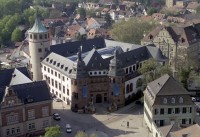Karte im Querformat. Auf der Vorderseite: Zerstörte Gebäude in Etain. Auf der Rückseite: Adressat: "Frau Selma Kantlehner Köln am Rhein Aachenerstraße 28 II", Poststempel vom 18. Mai 1916. Der Text lautet:
"Im felde, d.17.5.1916/ M.L. Frau m. Kindern!/ Gestern bei meiner/ Rückkehr von vorne, fans ich/ das Packetchen mit dem Fläschchen/ vor, schmeckt ausgezeichnet!/ das ist allerdings gang was anderes/ als das neulich u. ich schreibte da-/ mals schon, das (...) (...) (...), nunr recht herzl.Dank(?) sandte/ die vorgestern ein Brief/ ab, schreibte ob du denselben(?)/ erhalten hast. Sende dir nun/ samt den Kindern recht/ herzl. Grüße dein Ernst."
en









